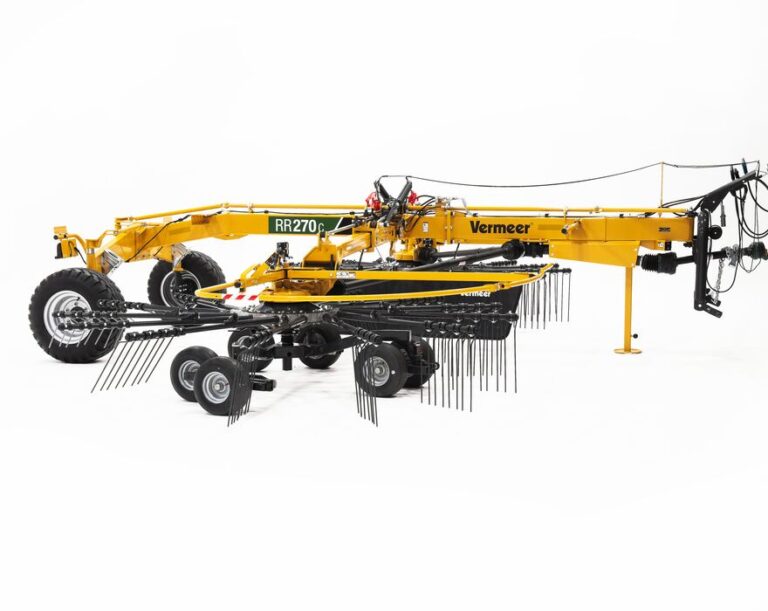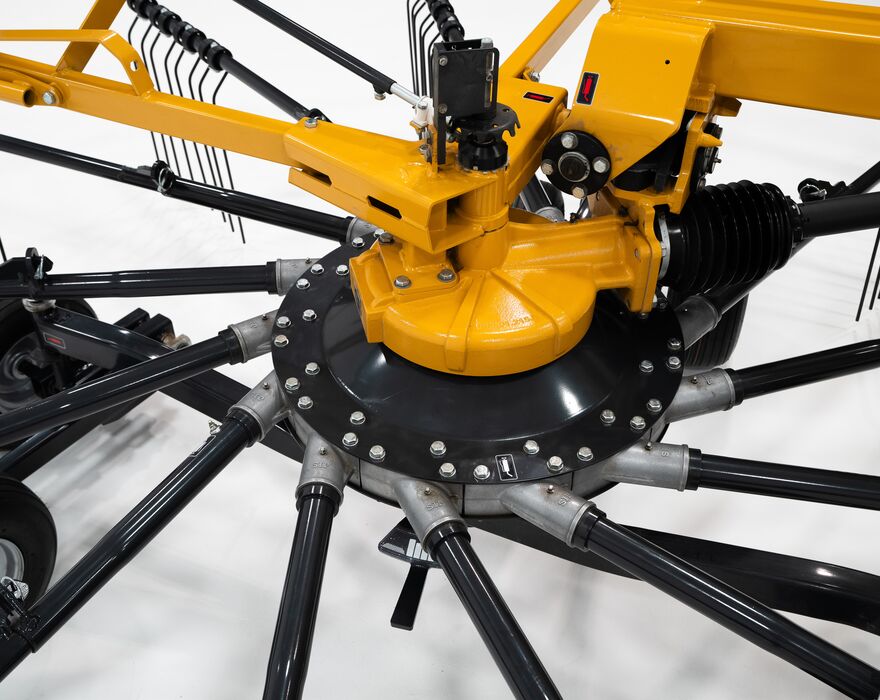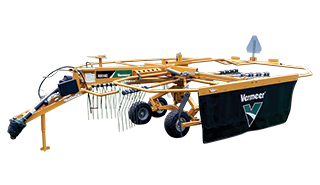
Rotary rake FAQ: What is a rotary rake? Which Vermeer rotary rake model is right for me?
August 2025
When it comes to making quality hay, every step in the process counts. The rotary rake you choose plays a big part in the quality of feed you produce or sell.
Rotary rakes are gaining popularity, but you may have questions about what they are, how they work and whether one is a good fit for your operation. We’ve put together some common questions about rotary rakes and the benefits of using Vermeer equipment to help you get the answers you need. Let’s dive in!
What is a rotary rake?
A rotary rake is a special kind of hay rake made to gently sweep hay or forage into windrows for drying and later baling. Unlike wheel rakes that are ground-driven, rotary rakes usually run off the tractor’s power take-off (PTO), which means they work consistently in different crop conditions and at different speeds. They use spinning rotors with multiple tine arms to lift and move the crop, making fluffy, even windrows. This design helps make top-quality forage by picking up less dirt and ash, which is a key focus for Vermeer rakes.
What are the benefits of using a rotary rake for my hay operation?
Rotary rakes have several good points for producers who want good quality hay and want to work efficiently. Key benefits include:
- Better hay quality: Leads to cleaner hay with less spoilage and more nutrients.
- Faster, more even dry-down: Fluffy windrows promote airflow, helping hay dry quicker so you can bale sooner.
- Consistent, well-shaped windrows: Makes for smoother baling or chopping, especially with chopper balers. The Vermeer RR270C, for instance, has an optional swath curtain to help with this.
- Versatile in different conditions: Handles various crop types and conditions, including wet or heavy hay.
- Follows the ground well: Excellent suspension, like the walking tandems on Vermeer RR140S and RR270C models, means they pick up more hay and are gentler on your fields, even rough ones.
For more ideas on picking the right rake, you might find our articles on expert advice on simplifying your rake selection and choosing the right hay rake for the job helpful. Your local Vermeer hay and forage equipment dealer can also help.
How will a rotary rake help me put up high-quality hay?
A rotary rake can support making high quality hay in a few ways:
- Picks up less dirt and trash (less ash): The main way rotary rakes improve hay quality is by lifting the crop instead of rolling it. This means less dirt, rocks and other debris get into the windrow. Producers often see much cleaner hay. Clean hay means better feed value and less risk of health problems for animals. Vermeer rotary rakes include design features, like easy height adjustment, to help achieve this.
- Gentle on the crop: The sweeping action of a rotary rake is gentler than some other rake types. This helps preserve precious leaves, where many of the nutrients are located. The tine arm design on Vermeer rotary rakes, for example, is made to lift the crop effectively and gently.
- Makes fluffy, airy windrows for better drying: Because rotary rakes create light and airy windrows, air can move through the hay easily. This not only speeds up drying but also helps prevent mold and keeps the forage fresh. A good-looking bale starts with a good-looking windrow, and Vermeer rotary rakes, with features like large cam tracks, are built for this.
What are the differences between rotary rakes, wheel rakes and twin rakes?
Choosing the right rake depends on what you need and what’s important to you. Here’s a general comparison:
Rotary rakes vs. wheel rakes
- Drive system: Rotary rakes run off the PTO, so the rotor speed stays the same even if your tractor speeds up or slows down. Wheel rakes are ground-driven. This means a Vermeer rotary rake can work its best even if you change your tractor speed.
- Crop handling: Rotary rakes lift and gently set down the crop, making cleaner hay that doesn’t rope up as much and holds together better in the windrow. Wheel rakes can sometimes get balled up or plugged.
- Wet hay: Rotary rakes do a better job with wet hay.
- Cost and upkeep: Wheel rakes are generally more affordable and easier to maintain. Rotary rakes are more complex machines with additional wear points but offer enhanced features for convenient maintenance. You might choose a rotary rake if you want top-quality hay, need to rake wet hay or want cleaner corners and to pick up the crop better. A wheel rake might be a better choice if you’re looking for something cheaper, simpler, faster in some spots or for things like cornstalks, where some producers find they rake cleaner.
Rotary rakes vs. twin basket rakes (often called “twin rakes” here)
- Windrow shape: Rotary rakes are known for making fluffy windrows. Twin rakes can sometimes “rope” the hay if not adjusted correctly, which makes it harder to dry. Vermeer rotary rakes are designed to produce a nice, fluffy windrow.
- Following the ground: Rotary rakes usually follow the ground better than twin rakes, so you don’t miss as much hay or dig into the dirt. This is particularly important on hilly or uneven ground, where the special walking tandem design from Vermeer works exceptionally well.
- Upkeep and setup: Twin rakes are often seen as needing less upkeep, costing less to own over time, and being easier to prepare with fewer adjustments. However, the rotary rakes available from Vermeer are designed to be easy to use and repair, featuring parts that can be easily swapped out and adjustments that can be made without tools.
You may opt for a rotary rake to achieve better ground following and produce fluffier windrows. A twin rake might be favored since it has a proven design, retains its value, needs less maintenance and is simple to operate.
For a deeper dive, consider our article on, “What’s the best hay rake for you?”.
Does Vermeer carry rotary rakes, and what makes them stand out?
Yes, Vermeer offers a line of rotary rakes built to be tough, easy to use and produce top-quality forage. The key features of Vermeer rotary rakes include:
- Tough, smart design: Built tough for rough conditions, Vermeer rotary rakes have strong modular rotors, big cam tracks and heavy-duty parts so they last and you can count on them. They’re designed that way on purpose to fix problems producers might have had with older rotary rakes. For example, the modular rotor design with parts you can replace one by one makes upkeep easier.
- Easy to use: Vermeer has prioritized operator convenience through simple adjustments and hassle-free maintenance. The cam angle and rake height can be adjusted quickly without tools. Quick-release linchpins on the tine arms allow for easy removal when transporting the rake or replacing damaged components. The partial lift feature enables rapid rotor lifting at row ends, saving time and preventing damage.
- Focus on top-quality forage: Vermeer rotary rakes are engineered to produce exceptionally clean forage. Their design emphasizes features that create light, airy windrows, minimizing dirt and ash content for the best possible feed.
- Great ground following: Features like the walking tandem design (standard on Vermeer models, often an option on others) let the rotors follow the ground smoothly, even when it’s rough, helping to make sure more crop gets picked up. The tires are also set close together and near the tines to give more support.
- Smooth running and easy service: Large 420 mm (16.5 in) diameter dry cam tracks help them last longer and run smoothly, without needing a lot of upkeep. The Y-drive gearbox on models like the RR270C is designed so the PTO angle is better, which makes the driveline last longer than some other T-drive systems you see out there.
- Easy to handle: The RR270C twin-rotor model has a steerable axle connected with a two-point hitch system. This makes it easier to handle in the field and when moving, allowing you to use a large piece of equipment in tighter spots and helping it follow the tractor smoothly on turns.
Which Vermeer rotary rake model is right for me?
Vermeer offers several rotary rake models to fit different farm needs. Models include:
- Vermeer RR140S rotary rake: This single-rotor, side-delivery rake stands out for its robust construction and premium materials. It features 12 tine arms (each with four double tines), a strong modular rotor, two walking tandems, and large cam tracks at420 mm (16.5 in). With toolless adjustments and a raking width of 14.1 ft (4.3 m), it requires a minimum 27-hp (20.1-kW) tractor.
- Vermeer RR270C rotary rake: This twin-rotor, center-delivery rake is built for larger operations that need wider raking widths at23.7 ft to 27.2 ft (7.2 m to 8.3 m) and high efficiency. It features a modular rotor design, with three walking tandems per rotor (each equipped with 13 tine arms and four double tines), and a steerable axle for excellent maneuverability. The cart-mounted rake requires a tractor with at least 55 hp (41 kW).
To choose the best model for your farm, consider your acreage, typical crop conditions and existing equipment. For more guidance, check out our Vermeer hay equipment guide.

How can I buy Vermeer rotary rakes, and is financing available?
Vermeer rotary rakes are available through authorized Vermeer dealers in your area. Your local dealer will demonstrate how the equipment works, provide detailed information and help you select the model that best suits your operation. They’re also your primary contact for service and parts. To locate your nearest Vermeer dealer, visit the Vermeer dealer locator.
Financing options are available for qualified buyers. Your local Vermeer dealer can explain current financing programs and assist with the application process.
About Vermeer Corporation
Vermeer delivers a real impact on the way important work gets done through the manufacture of high-quality agricultural, underground construction, surface mining, tree care and environmental equipment. With a reputation for being built tough and built in a better way, Vermeer equipment is backed by localized customer service and support provided by independent dealers around the world. To learn more about Vermeer, products, the dealer network and financing options, visit vermeer.com.
Vermeer Corporation reserves the right to make changes in engineering, design and specifications; add improvements; or discontinue manufacturing at any time without notice or obligation. Equipment shown is for illustrative purposes only and may display optional accessories or components specific to their global region.
Please contact your local Vermeer dealer for more information on machine specifications.
Vermeer and the Vermeer logo are trademarks of Vermeer Manufacturing Company in the U.S. and/or other countries. © 2025 Vermeer Corporation. All Rights Reserved.

